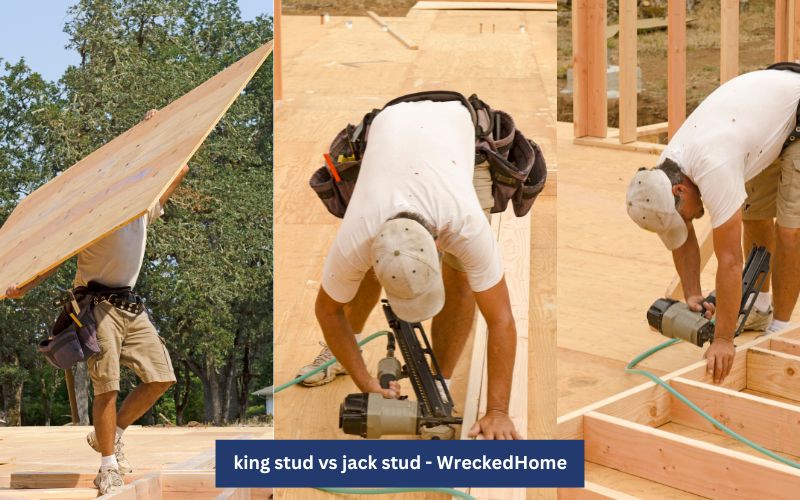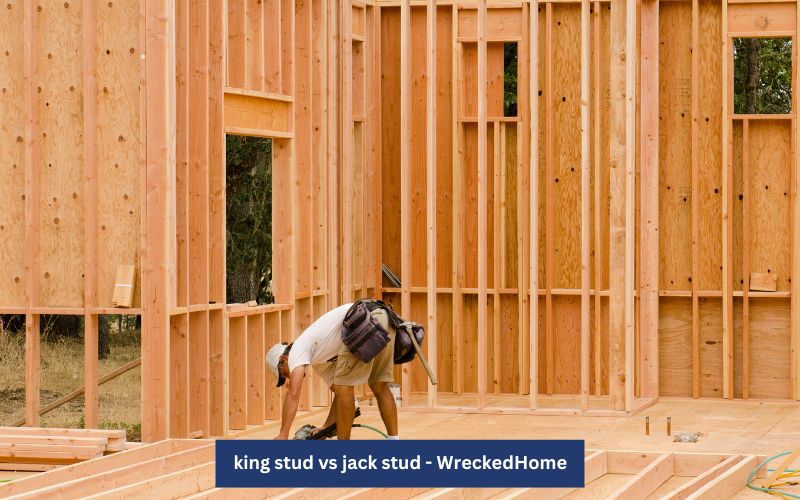Building a house is like assembling a gigantic puzzle, in which each piece is intricately designed to fit perfectly in its respective place. Just one mistake or one wrong piece and the entire picture could crumble!
In the construction industry, structure framing is a lot like putting together this puzzle. This skeletal structure is important to give a building its shape. It also provides a canvas for all other elements like walls, floors, and roofs.
Now, would you trust the core framework of a building to just any random piece of wood? The real unsung hero is the stud that give required frame work structure. They are vital components in framing that come in different types, each with its unique role according to windows and doors. You need to know your studs, especially when you’re considering a construction project, for seamless and easy work.
There are two common frames which are the jack stud and the king stud. One of the most common debates in the construction industry is which to choose between jack stud and king stud.
If you are also confused between these two studs for your project then you are in the right place. This article aims to dissect these two types of studs, discuss their differences, and evaluate their roles in construction. The knowledge of differentiating between the king stud vs jack stud can make a world of difference in the strength, integrity, and longevity of your building.
So grab this opportunity and let’s dive into making your project successful!
What is a Jack Stud?
In the ensemble of building elements that make up a framed wall, think of the jack stud as the rhythm guitarist. While it might not grab the spotlight like the king stud—the structural “lead vocalist,” it is absolutely crucial in laying down the backbone of a killer song—or in this case, a rock-solid structure.
So, what exactly is the jack stud in straightforward terms? Simply, it’s a vertical wooden piece situated beside openings in a framed wall, such as those for windows and doors. Its job is to offer support to the header, the horizontal element which runs continuously from the top to the bottom plate of a wall frame. It starts at the bottom plate and rises only as high as the header it supports.
What’s its purpose?
Why is the jack stud important, you might wonder? The jack stud acts like the trusty sidekick, providing additional support to the header and that ensures the wall’s stability. This added support ensures the wall can withstand the weight of the structure above, while also creating a secure base for the installation of windows and doors.
As for setting it up installation, it is generally straightforward. Once the king studs and headers have been positioned jack studs are cut to fit the exact height needed to support the header. They are then attached to the king studs flanking the opening, often using nails or screws for secure attachment.
So, the next time you walk through a door or glance out of a window, remember the jack stud—the unsung hero holding it all together.
What is a King Stud?
If the jack stud is the rhythm guitarist of the construction world, the king stud is certainly its front man or lead vocalist. It’s the piece of lumber that often gets the spotlight, running continuously from the top to the bottom of a wall frame, and with good reason!
What makes the king stud worthy of its regal designation? A king stud is a full-length vertical stud that flanks the sides of windows and door openings in framed walls. Unlike the jack stud, which is primarily there to offer support to the header, the king stud serves as the primary load-bearing element. Its mission? To channel the weight from the wall’s top plate straight down to the floor, ensuring that you’re building remains standing tall and proud.
In essence, while jack studs provide specialized support to openings, the king stud serves as the structural linchpin for the entire wall. Their job is so vital that they usually run uninterrupted from the top plate to the bottom plate of your wall framing that provides an unbroken path for weight distribution.
As for installation, a king stud is relatively straightforward but extremely crucial during framing. Once aligned, it’s fastened securely to both the top and bottom plates, positioned according to the planned openings for doors and windows.
So there you have it— an essential protagonist in the architectural drama, responsible for maintaining basic skeletal structure of the wall in its rightful place.
Differences between king stud vs jack stud
Structural Role: king stud vs jack stud
Thinking of king stud vs jack stud: one’s the strategist, and the other is the muscle. That’s the dynamic between king stud vs jack stud in the realm of framing. The king stud serves as the backbone of the entire wall, a foundational force that holds the entire wall frame together. Running continuously from the top plate down to the bottom plate, that ensures weight is evenly distributed across the wall.
On the other hand, the jack stud is the specialist, the tactical genius of the pair. It focuses on specific areas around the openings for windows and doors, and provides targeted support to ensure they can handle additional weight and stress. While the king stud deals with maintaining the general structural integrity of the wall, making sure they are as secure as the rest of the structure.
Installation and Positioning: king stud vs jack stud
In the symphony of wall construction, both the jack and king studs are essential. They have distinct roles to play and specific locations where they perform best. The king stud takes the stage first, anchoring itself to both the top and bottom plates.
Enter the jack stud, taking its place a bit later and here’s where teamwork really shines. Installed beside the king studs, they are supporting the header above the window or door openings. The jack stud is like the backup singer that stands beside the lead vocalist, key to enhancing the performance but focusing on particular elements of the song.
Material and Load-Bearing Capacity: king stud vs jack stud
Typically, both king and jack studs are constructed from similar kinds of materials, usually lumber like spruce, pine, or fir, or sometimes engineered wood products. However, their load-bearing responsibilities often require a higher grade of material, especially for taller or commercial buildings.
Conversely, jack studs focus on localized support around openings, may not need as high a grade a material as king studs.
Structural Integrity: king stud vs jack stud
Consider the king and jack studs as the bolts and screws of a well-oiled machine. King studs serve as the main load-bearing elements, maintaining the overall structural integrity. They’re the backbone of any wall framing.
Jack studs, play the role of specialized reinforcements, focusing their strength on particular points of doors and windows—that can be weak links in the wall’s structure. So, in essence, the king studs maintain the structural integrity of wall frame, on the other hand jack studs enhance that wall’s integrity at weak spots.
Cost and Efficiency: king stud vs jack stud
When evaluating cost and efficiency, jack studs can sometimes be more cost-effective because they are shorter and require less material. However, the savings in material costs might be offset by spending more on labor installing the additional jack studs next to the king studs. On the flip side, king studs, requiring a higher grade of material, can be more expensive.
Yet, their simpler, vertical installation usually demands less time and complexity in installation, given their more straightforward, vertical positioning. So in term of efficiency and cost effectiveness everything depends upon your project requirement.
Visit our store for 10% off our Tools here.

Real-world Applications and Examples
Before we delve into real-world examples, it’s essential to grasp that the roles of jack studs and king studs are not mutually exclusive; they’re more like a dynamic duo in the framing world. Whether you’re building a cozy home or a towering commercial complex, the interplay between these two types of studs is crucial.
So, let’s get concrete—literally—and explore how jack and king studs make a difference in various construction settings. Ready to see these studs in action? Let’s dive in.
Residential Construction
Ever walk through your home admiring how flawlessly everything comes together? In residential construction, king studs serve as the core structural elements of your walls. They function as the primary pillars that hold up everything from the roof to the drywall.
When you decide to put in that beautiful bay window or a new doorway, jack studs join the ensemble. They offer specialized support around these openings, ensuring that the wall remains strong despite having a gap in it.
Commercial Construction
In the world of commercial construction, the stakes are even higher. King studs often graduate from lumber to higher-grade materials due to the increased load. Jack studs in commercial settings are equally crucial.
Together, king and jack studs act as additional hardware or fasteners used in conjunction with jack and king studs in commercial.
Conclusion
In the complex arena of construction, understanding each component’s role of king stud vs jack stud is paramount to building safe and durable structures. The king and jack studs are framework’s backbone, ensuring overall structural integrity.
Together, they’re a dynamic duo for anyone venturing into construction or even those planning simple home renovations, understanding this interplay is crucial.
For any repairs, installations, builds, or questions; We recommend you to hire a professional. Find A Pro Near You Here!





































